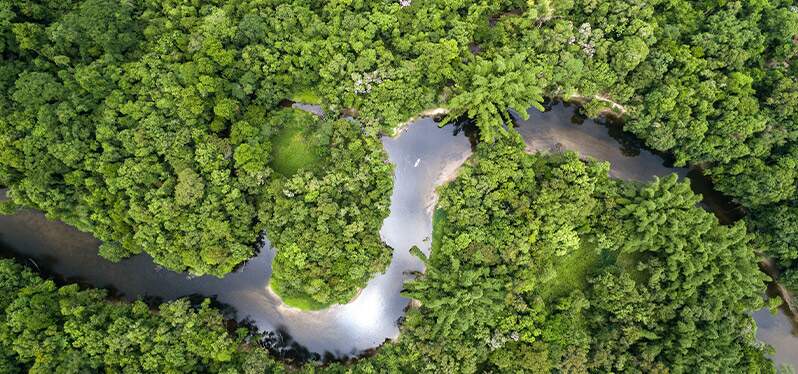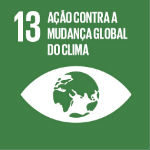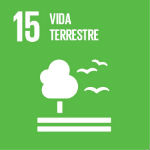Posted in: 07/30/2021
Protecting forests is essential to sustaining life on Earth.
Protect, preserve, and restore: these are the three words that should guide our reflection on the forests and the rich biodiversity they shelter, essential for the maintenance of life on the planet.
According to the United Nations (UN), humans have already altered almost 75% of the earth’s surface with their activities. This includes nature, the forests, and the life forms that need it and are increasingly restricted to small portions of territories that are not assaulted and/or protected.
It is worth remembering that ensuring the protection of terrestrial ecosystems corresponds to the 15th of the Sustainable Development Goals (SDGs) created by the UN:
In addition, the impact of forest degradation is already causing previously unthinkable results for nature. When could we imagine that the Amazon, for example, would ever emit more carbon dioxide than it is capable of absorbing?
This was the conclusion of a recently published study. According to the scientific journal Nature, burning and deforestation have turned the Amazon into a source of carbon gas release, emitting 0.29 billion tons per year more than it can assimilate.
This kind of change in the environment, like climate change, is a consequence of the unsustainable and abusive use of the planet’s resources. This includes the lack of protection for forests and other ecosystems.
The climate, our health and that of the environment, food and water security, are all elements that depend directly on nature and forest areas.
The aggressions against the environment can be many, and have serious consequences. To illustrate, we highlight the 6 main threats to forests and biodiversity.
Changes in land use
Increasing transformation of forests into agricultural land, with no possibility of regenerating devastated biomes.
Direct exploitation of organisms
Overexploitation of natural resources, such as the misuse of water resources and the felling of trees for wood.
Climate change
Destruction of habitats for various species of fauna and flora, caused by extreme weather events, high temperatures, floods, desertification and flooding, among others.
Pollution
Mainly caused by the use of chemicals and untreated sewage, deposited directly in nature.
Invasive Species
Species that are taken, usually by human presence, from their natural habitat to others and, because they have no natural predators, become a risk to the balance of the local ecosystem.
Unsustainability of consumption
Our accelerated form of consumption, and the consequent generation and accumulation of waste without correct treatment, has taken the planet to extreme levels of wear and pollution.
Source: Global Assessment Report, released in 2019 by the Intergovernmental Platform on Biodiversity and Ecosystem Services (IPBES)
Human interventions may be the main factor in the imbalance of natural ecosystems, but they also have the power to realize solutions to conserve biodiversity and reverse damage.

Therefore, we also highlight some of the actions that can be put into practice by the various actors that need to be involved in forest protection processes, including governments, the public and private sectors and communities. In other words, all of us. They are:
Besides the actions mentioned above, we must remember that a great part of the deforestation occurs for the economic exploitation of the forest resources, but that there are several ways to reach this productive and financial potential in a less aggressive way to the environment, and also to stimulate the regenerative economy and the sustainable development of the region. Investment in the bioeconomy may be one of them. Want to know how?
Check out the article “The rise of the bioeconomy as an alternative to the development of the Amazon”.
With the advance of the consumption of natural resources, it is estimated that the preservation processes alone will not be enough to avoid an imminent collapse in the productive systems. It is necessary to invest in restoration.
In other words, in addition to protecting and preserving, countries must commit to implementing action plans aimed at restoring the planet’s ecosystems to mitigate the impacts of the triple threat: Loss of Nature, Climate Change and Pollution.
But how to guarantee the alignment of government policies to these guidelines? How are the national institutions working on this agenda and how will they guide society to do its part?
You will find many answers to these questions at the “Socioenvironmental on the Agenda: Solutions and Challenges of Ecosystem Restoration” Broadcast, promoted by Synergia.

The event, online and free of charge, will feature Isabella Salton, executive director of Instituto Terra, Mario Mantovani, mobilization director of SOS Mata Atlântica, and the Founder and CEO of Synergia, Maria Albuquerque, who will discuss restoration trends and actions for national ecosystems.
It will be on August 12th, at 5 PM. Don’t miss out!


Sign up and receive our news.